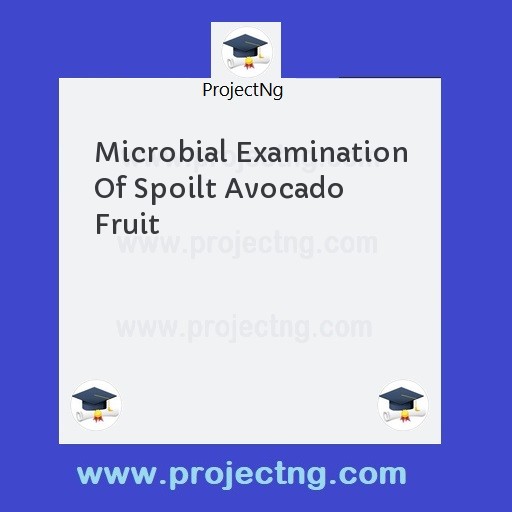Microbial Examination Of Spoilt Avocado Fruit
Science Lab Technology Project Topics
Get the Complete Project Materials Now! »
MICROBIAL EXAMINATION OF SPOILT AVOCADO FRUIT
ABSTRACT
Microbial examination of spoilt Avocado fruits was carried out to obtained the causal organism. A total of 60 avocado from Ogbete Main market and New market Enugu were examined by culturing on nutrient agar and sabourand dextrose agar (SM), for bacteria and fungi causing post – harvest spoilage on the fruits; six bacterial species and six fungal species were isolated. The bacteria include Erwinia SP (66.7%), Streptococcus sp, *25%), E. Coli (18.9%) and staphycoccus sp (33.3%), Pseudomonas sp (20%) and Chromobacterium sp (5%) has the lowest percentage occurrence, Erwinia sp, Pseudomonas sp and chromobacterium sp were found to be absent in the control. The fungi species, includes Aspergillus sp (50%), Pericillium sp (25%), Fusarium sp (16.6%), Rhisopus sp (13.3%), currularia sp (8.3%) and Rhoctorula sp (3.3%), were also kolated Avocado fruits from Ogbete main market were more contaminated than the avocado form the new market.
TABLE OF CONTENTS
Title page
Certification
Dedication
Acknowledgement
List of Tables
List of figures
Abstract
CHAPTER ONE
Introduction
1.1 Background of study
1.2 Statement of problem
1.3 Aim and Objectives of the study
1.4 Hypothesis
1.5 Significance of the study
1.6 Limitation of the study
CHAPTER TWO
Literature review
2.1 The origin of Avocado fruits
2.2 Uses of avocado fruits
2.3 Preservation of avocado fruits
2.4 Ways avocado fruits can be prone to contamination
2.5 Microbial spoilage of avocado fruit
2.6 Control of bacterial and other disease of avocado fruits and fruits products
2.7 Some biochemical test for bacterial isolates
CHAPTER THREE
Materials and methods
3.1 Sample collection
3.2 Sterilization of media an material used
3.3 Preparation of media
3.4 Bacteria and fungi isolate from avocado fruits
3.5 Bacterial isolation and identification
3.6 Fungal isolation and identification
3.7 Lactophenole blue staining technique for fungi isolates
3.8 Staining techniques for bacteria isolates grains stain
3.9 Biochemical test for identification of bacteria isolates
CHAPTER FOUR
Results and discussion
4.1 Bacterial Examination
4.2 Fungi, examination
CHAPTER FIVE
Conclusion and recommendation
5.1 Conclusions
5.2 Recommendation
Reference
LIST OF TABLE
Table I: Bacterial isolated and their frequencies
Table 2: Fungi isolated and their frequencies
Table 3: Sources of collection of the fruit and Bacteria isolate
Table 4: Sources of collection of the fruits and fungi isolates
LIST OF FIGURES
Fig. 1: Rate of occurrence of fungi
Fig. 2: Rate of occurrence of bacteria
Fig. 3: Fungi isolates according to sources
Fig. 4: Bacteria isolates according to source.
CHAPTER ONE
1.0 INTRODUCTION
1.1 BACKGROUND OF STUDY
The Avocado pear, Persea Americana is a tropical and sub tropical fruit tree, originated in central America or adjoining regions of North or South America. It has now spread to much of the near tropical world. The avocado is limited especially by its climatic requirements, with their race differences. It is also highly susceptible to drought injury. But excess soil moisture is equally fatal, encouraging the dread phytophthora root rot in most of the world, and where the fungus is unknown. Despite the high water activity of most fruits, the how PH leads to their spoilage being dominated by fungi, both yeast and moulds. Other common diseases of pears include the black spot or scab caused by as comycetes
Avocado fruits has being estimated that one fourth of all produced harvested is no consumed before spoilage (Salulche, 1974), spoilage of fresh fruits usually occurs during storage and transport and while wacting to be processed unlike many other foods fruits after picking and before processing are ‘a live’ of the products plus the normal ripering process complicate an independent discussion of the microbiological spoilage problems are really market diseases of these products:
Shape, varies from slightly obligate to highly elongate, an intermediate oval or pear shape is preferred. Yellow to purple or black.
The composition of the fruit influences the likely type of spoilage. thus bacteria soft rot is widespread for the most part among the fruits is limited to those that are not highly acid. Because most fruits are somewhat acid are fairly dry at the surface, and are deficient in B vitamins, mold are the most common causes of spoilage. The compositions too, must determine the particular kind of molds most likely to grow, thus avocado support a large, variety of fungal spoilage organisms and other kinds comparatively few.
1.2 STATEMENT OF PROBLEM
Micro-organisms are known to destroy fruits, thereby reducing the quantity for consumption and the profits desirable from fruits such as avocado. Many spot are noticed on pears which do change the taste when consumed.
Bacteria and fungi are harmful and useful living organisms. The spoilage of most fruits is always associated with bactera and fungi, many diseses of plants are associated with bacteria and fungi (Micro-organisms)
The adverse effect of bacteria in plants and fruits has resulted in shortage of avocado fruits for consumption. Revenue is lost by farmers and industries that uses avocado fruits as a raw materials for fruit juice due to the spoilage caused by micro-organisms.
1.3 AIM AND OBJECTIVES OF THE STUDY
Microbial examination of spoilt avocado fruits
To isolate and identify how micro-organism destroy avocado so as to guide producer and farmers on how to manage the fruits
Be the First to Share On Social

Enjoying our content?
Don't miss out on new videos! Subscribe to our YouTube channel for more awesome content.
Subscribe Now!













